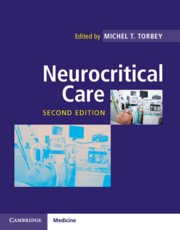38 results
Chapter 4 - Hypothermia in the Neurocritical Care Unit: Physiology and Applications
-
-
- Book:
- Neurocritical Care
- Published online:
- 24 July 2019
- Print publication:
- 18 July 2019, pp 28-32
-
- Chapter
- Export citation

Neurocritical Care
-
- Published online:
- 24 July 2019
- Print publication:
- 18 July 2019
Contents
-
- Book:
- Neurocritical Care
- Published online:
- 24 July 2019
- Print publication:
- 18 July 2019, pp v-vi
-
- Chapter
- Export citation
Copyright page
-
- Book:
- Neurocritical Care
- Published online:
- 24 July 2019
- Print publication:
- 18 July 2019, pp iv-iv
-
- Chapter
- Export citation
Index
-
- Book:
- Neurocritical Care
- Published online:
- 24 July 2019
- Print publication:
- 18 July 2019, pp 442-458
-
- Chapter
- Export citation
Contributors
-
- Book:
- Neurocritical Care
- Published online:
- 24 July 2019
- Print publication:
- 18 July 2019, pp vii-x
-
- Chapter
- Export citation
Chapter 32 - Management of Delirium in the Neurocritical Care Unit
-
-
- Book:
- Neurocritical Care
- Published online:
- 24 July 2019
- Print publication:
- 18 July 2019, pp 392-396
-
- Chapter
- Export citation
Preface
-
- Book:
- Neurocritical Care
- Published online:
- 24 July 2019
- Print publication:
- 18 July 2019, pp xi-xii
-
- Chapter
- Export citation
Chapter 18 - Management of Autoimmune Encephalitis in the Neurocritical Care Unit
-
-
- Book:
- Neurocritical Care
- Published online:
- 24 July 2019
- Print publication:
- 18 July 2019, pp 233-237
-
- Chapter
- Export citation
Introduction
-
-
- Book:
- The Stroke Book
- Published online:
- 05 August 2013
- Print publication:
- 18 July 2013, pp xiii-xiv
-
- Chapter
- Export citation
Section II - The Hunt for a Stroke Etiology
-
- Book:
- The Stroke Book
- Published online:
- 05 August 2013
- Print publication:
- 18 July 2013, pp 47-92
-
- Chapter
- Export citation
Plate Section
-
- Book:
- The Stroke Book
- Published online:
- 05 August 2013
- Print publication:
- 18 July 2013, pp -
-
- Chapter
- Export citation
Section V - Stroke in Consultation
-
- Book:
- The Stroke Book
- Published online:
- 05 August 2013
- Print publication:
- 18 July 2013, pp 257-304
-
- Chapter
- Export citation
Index
-
- Book:
- The Stroke Book
- Published online:
- 05 August 2013
- Print publication:
- 18 July 2013, pp 368-380
-
- Chapter
- Export citation
Copyright page
-
- Book:
- The Stroke Book
- Published online:
- 05 August 2013
- Print publication:
- 18 July 2013, pp iv-iv
-
- Chapter
- Export citation
18 - Antithrombotic therapies
- from Section VI - Prevention of First and Recurrent Stroke
-
-
- Book:
- The Stroke Book
- Published online:
- 05 August 2013
- Print publication:
- 18 July 2013, pp 305-318
-
- Chapter
- Export citation
1 - Emergency medical services (EMS): first line of defense against stroke
- from Section I - Assessment of Stroke Patients
-
-
- Book:
- The Stroke Book
- Published online:
- 05 August 2013
- Print publication:
- 18 July 2013, pp 1-10
-
- Chapter
- Export citation
List of contributors
-
-
- Book:
- The Stroke Book
- Published online:
- 05 August 2013
- Print publication:
- 18 July 2013, pp vii-x
-
- Chapter
- Export citation
Section IV - Management of Stroke Patients
-
- Book:
- The Stroke Book
- Published online:
- 05 August 2013
- Print publication:
- 18 July 2013, pp 175-256
-
- Chapter
- Export citation
The Stroke Book - Half title page
-
- Book:
- The Stroke Book
- Published online:
- 05 August 2013
- Print publication:
- 18 July 2013, pp i-ii
-
- Chapter
- Export citation



